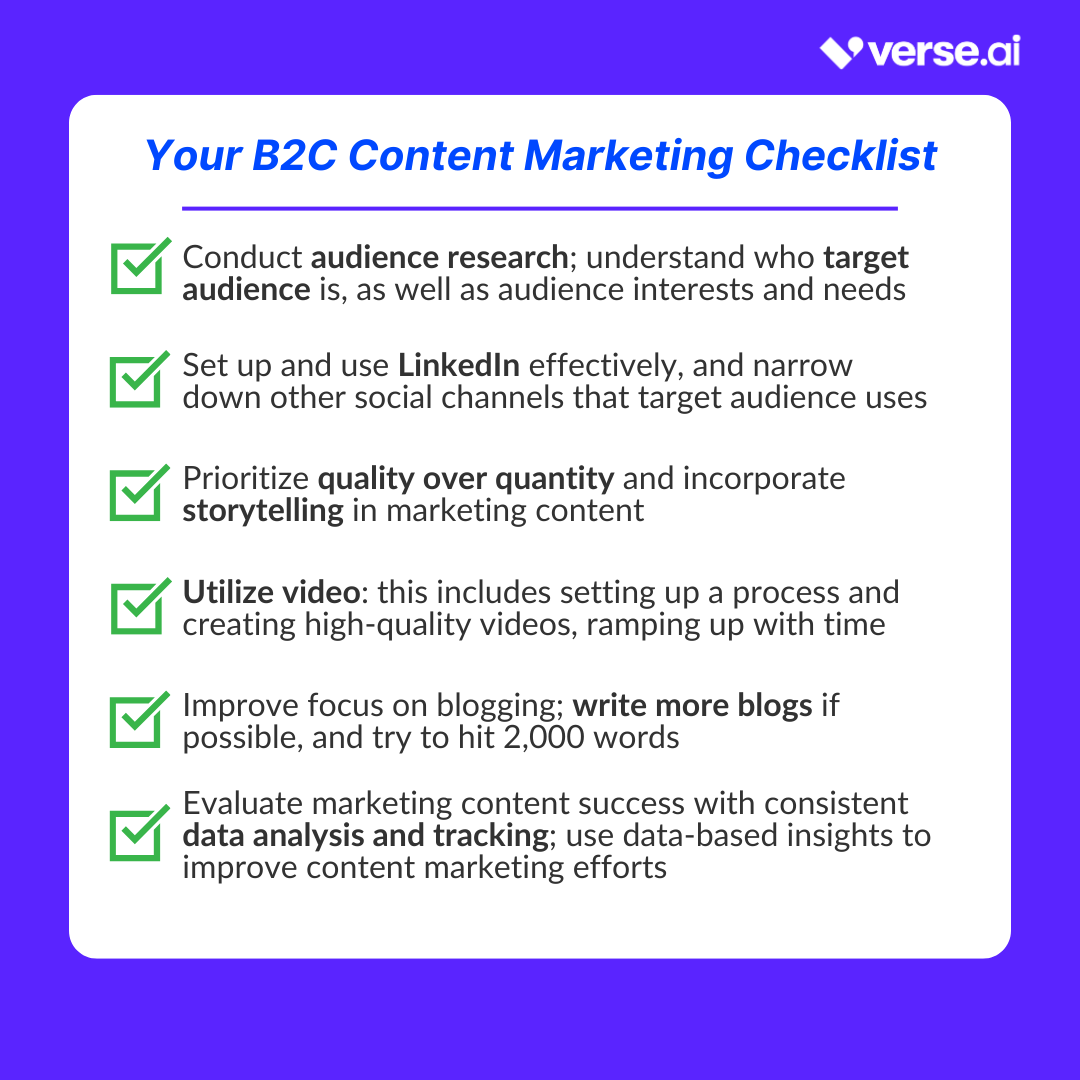Content marketing has risen in importance for B2C brands. Benefits of B2C content marketing include boosting customer lifetime value by up to 70% and conversion rates by 6x.
For B2C companies, content nurtures prospect relationships and drives sales, improving lead generation, conversion rates, web traffic, and brand trust.
Ultimately, this is because content marketing focuses on helping, not selling.
By doing so, quality content positions your company as a resource that consumers can trust—and creates more buzz about your brand.
86% of B2C marketers use content marketing—but is your content strategy checking all the boxes?
In this blog, we’ll discuss B2C content marketing statistics as well as six essentials on a modern content marketing checklist.
B2C content marketing statistics
- For 74% of companies, content marketing is effective in boosting lead generation. Because content is informative and tailored to audience needs, it can attract more leads by providing them with valuable information.
- Content marketing is relatively cheap; most businesses spend $1,000 or less per month on content marketing.
- While content marketing costs 62% less than outbound marketing, it generates more than three times as many leads.
- Companies that use content marketing have 6x higher conversion rates than those that do not.
Why B2C content marketing is so successful
Well-crafted B2C content marketing provides helpful, informative content that serves your customers’ needs.
Content is very effective because it helps to create authentic connections with your target audience in a way that is not directly self-serving for your brand.
Helpful content can foster trust with your audience while improving brand reputation.
The importance of consumer trust cannot be overstated; trust is what leads to the sale of your product, as well as continued brand loyalty.
The modern B2C content marketing checklist
As the importance of B2C content marketing is well-established, it’s vital that your marketing strategy is up-to-date.
Here are six essentials to a successful, modern content marketing strategy. Is your content marketing team doing these six things?
Audience research for B2C content marketing
When it comes to content creation, the most frequently-cited challenge is creating the right content for the audience. 57% of content marketers struggle with this.
However, audience research is one of the most important contributors to content marketing success. When you understand your audience’s needs and interests, you can craft content that resonates.
Without that understanding, your hard work could go to waste.
The first step to audience research is understanding who your target audience is. Narrow down their demographics (such as age, location, and job titles) and behavior (online activity, buying habits).
Next, you want to understand their psychographics: their interests, opinions, and lifestyle.
There are many ways to research this:
- Customer interviews. Customer feedback is incredibly valuable, and customer conversations can help you better understand their point of view.
- Reviews. What information are people leaving you online? Reviews are always useful in better understanding your audience; what are they telling you about themselves in the review? What problems are you solving for them?
- Surveys. You can send surveys via email or ask customers during regular conversations. To get more responses, you can even offer rewards for filling out a survey.
- Social media. Look at how your social media followers are interacting with your content. What are they liking and sharing? Social media is also a great place to ask questions and gain feedback.
- Google Analytics. Check out how visitors on your website are interacting with your content so far. What are they liking the most?
- Email marketing platforms. When you look at what emails are performing the best, that can clue you into what customers are most interested in.
- CRMs. Your team should be keeping track of customer interactions in your customer relationship management (CRM) software; this can show you who your customers are, and what their pain points might be.
- Competitor analysis. Check out what your competition is doing by monitoring their social media channels, website, and reviews. What are they doing that you are not? Find the gaps in their content that you can fill.
LinkedIn for B2C content marketing
Traditionally, LinkedIn is used for B2B marketing.
However, in 2024, LinkedIn is the most popular social media platform used for B2C marketing; 93% of B2C marketers use LinkedIn.
Built around professional networking, LinkedIn dominates the other platforms for B2C because it helps brands connect to a more targeted audience with their social media marketing.
While LinkedIn is a professional audience, they’re still consumers. Don’t forget that these people still have decision-making power with their own purchases, and will buy products and services for their homes and families.
While LinkedIn has an audience for almost every industry, a huge advantage of the platform lies in its sophisticated ad targeting, which enables business marketing to target exactly who they choose.
Even if you don’t have budget for LinkedIn ads now, simply posting on LinkedIn can improve your content strategy and performance.
At the end of the day, LinkedIn is still a social media channel that people access in their free time. When people are browsing social media, they’re still looking for something that suits their interests.
There is plenty of space to appeal to audience interests beyond just work.
Plus, when you use social media marketing that falls outside the box on LinkedIn, you stand out more.
However, choice of social media platforms goes back to your audience research, as well as your product niche. Be sure to check which social media channels are most-loved by your audience.
Here’s a breakdown of how B2C marketers are using social media channels:
- 93% use LinkedIn.
- 88% use Facebook.
- 73% use Instagram.
- 67% use YouTube.
- 61% use Twitter.
- 23% use Pinterest.
- 18% use TikTok.
Quality over quantity
This one might seem obvious, but it can’t be overstated.
In B2C content marketing, there is often less focus on quality content than there is in B2B marketing.
An overlooked problem with much of content marketing is a marketing-first perspective: creating content only based around marketing initiatives.
While initiatives and goals are important, successful content is built with a customer-first mindset. This goes back to audience research.
In addition, B2C content marketing is often quantity over quality, while quality is really what makes content marketing effective.
Your brand won’t stand out for creating tons of content that no one asked for—your brand will stand out for creating something that is genuinely useful.
In a crowded market, storytelling is more important than ever to make your company memorable and authentic.
When you use storytelling and emotion to paint a picture of how your product or service fits into the life of the consumer, it creates a more memorable vision for how people can use the product—rather than just talking about product benefits and how it works.
With the amount of ads that consumers see every day, authenticity in content marketing increases your credibility.
When you weave stories into your content (in your website, blogs, social media posts, etc.) it helps make it more relatable and authentic.
At the end of the day, no one is asking for your company to create marketing content except, well, your company. Make it worth everyone’s while so that other people are glad you did—not just your company.
Video in B2C content marketing
If you’re not using video in your content marketing, you probably should be.
Here’s a few key statistics that prove the effectiveness of video marketing:
- 97% of marketers report that video helps customers understand their products better.
- 95% see increased brand awareness through video marketing.
- 90% attribute lead generation success to video content.
- 87% link video content to sales growth.
Meanwhile, this year, 89% of consumers say they want more videos from brands.
However, only 7% of marketers believe they are using video to its full potential—meaning there is plenty of opportunity here for content marketers.
Here are a few tips for better utilizing video in your content marketing:
- Define your goals. For every video, note what you want the viewer to do when they’ve finished watching. Is your video educational? Promotional?
- Develop a video process with thought and intention. Then, implement that process for every video.
- Again, focus on quality before quantity. Start by producing quality video content. Once you have the process down, you can work up to creating more quality videos.
- Use the right platforms for video distribution. This goes back to audience research—where do your customers spend their time online? Make sure you’re putting the video in all the right places to grab your audience’s attention.
- Track video performance. Evaluate how each video performs (this includes views, watch time, and conversions) so you can iterate on your process to improve metrics over time. Keeping track of videos’ return on investment (ROI) allows you to gain more video budget, increasing your capability.
Blogs for B2C content marketing
Blogging is an essential part of any content strategy. If you’re not using blogs in your B2C content marketing, you should definitely start.
Why? Not only is blogging vital for search engine optimization (SEO), but also:
- Almost 50% of customers read your blog before deciding to buy.
- Blogging is budget-friendly at 60% cheaper than traditional marketing.
- Marketers that blog gain 97% more backlinks than marketers who don’t.
Most marketers already realize the importance of blogs—but if you’re already using blogs, consider writing more. This means:
- Publishing more blogs: Businesses that publish 16 or more blogs per month generate 4.5x as many leads compared to other businesses.
- Writing longer blogs: Longer blog posts still correlate with content marketing success. Though the average blog length is 1,427 words, only 3% of businesses regularly publish blog posts longer than 2,000 words.
- Gaining more backlinks: Only 36% of B2C marketers focus on link-building as part of their content strategy. Backlinks are a huge part of search engine optimization, and there is a big opportunity here.
Data for B2C content marketing
Better use of marketing data is a big opportunity for B2C content marketers; right now, only about one-third of B2C content marketers say they always use data in their content strategies.
Data analysis allows marketers to base content creation on concrete information rather than conjecture.
This ties into audience research. When you know how your content is performing, you can serve your target audience better.
Data can help you understand:
- What types of content work best for your target audience (blog, video, ebooks, etc.)
- Which topics resonate the most with your target audience
- Where certain content types and topics are working the best (social media, email, website, etc.)
These are all very important factors in optimizing your content strategy—which can put you ahead of two-thirds of B2C content marketers.
Here are a few ways to use data analysis in content marketing:
- Track website visitor behavior: Use Google Analytics to see what engages your audience the most. This includes blog posts. In addition to noting blog performance, be sure you’re tracking your keyword rankings for search engine optimization (SEO).
- Evaluate social media channels: See which channels are converting best for your business and double down on those.
- Analyze social media performance: As mentioned earlier, track content performance on social media and identify trends. Do more with content types and topics that are getting the best engagement, likes, and shares—and reduce posting content that’s not performing as well. This could differ from channel to channel, so be thorough in your analysis.
- Measure email performance: Marketing automation platforms make it very easy to track metrics like open rate, click through rate (CTR) and bounce rate. Be sure that you’re checking these regularly and adjusting email content accordingly.
- Look in your CRM: Many companies use customer relationship management (CRM) software to track customer interactions. Be sure to note what type of content is converting. For those who ultimately bought, check what type of content they engaged with before buying.
Checklist for today’s B2C content marketing
To summarize, here is a short checklist for B2C content marketing success in 2024 and beyond.

Ask your team:
- Do we understand who our target audience is? Do we understand their needs and interests?
- Are we using LinkedIn effectively? What other social channels does our target audience use?
- Do we prioritize quality or quantity? Are we incorporating storytelling in marketing content?
- Are we using video effectively, if at all?
- Are we writing enough blogs? Are our blogs long or short?
- Are we using data to evaluate success and improve content marketing efforts?
Your partner for marketing ROI: Verse.ai
Verse helps you make the most of your hard-earned marketing leads with instant customer engagement, consistent follow-up, and customizable nurture.
Verse is a fully-managed, AI-enabled SMS platform that handles texting your leads and prospects for you.
We provide:
- Instant, 24/7 response
- Fully-managed, omnichannel communications
- Customizable scripts
- Automatic lead qualification
- Lead capture forms for your website
- Fast and easy integration with 1000s of CRMs
With real-time analytics and conversation history, we give your team insight into lead source performance so you can see which sources are truly delivering.
Say goodbye to missed opportunities and ineffective sales follow-up—and drive more marketing-sourced revenue.Verse is your partner for lead engagement for marketing.
See how much money you could make with Verse—try our ROI calculator!



